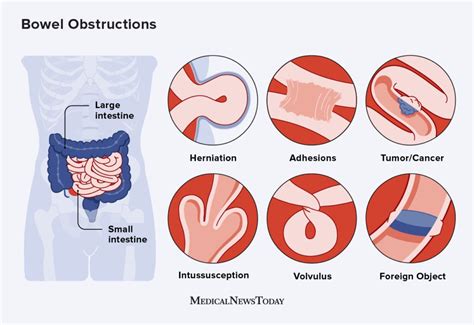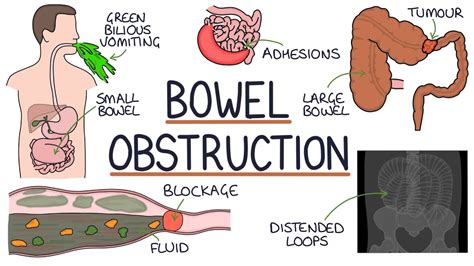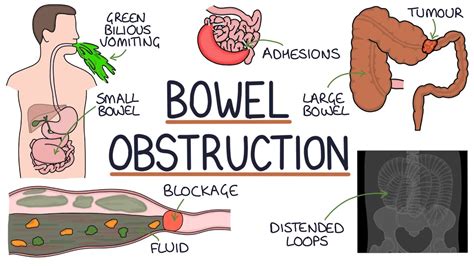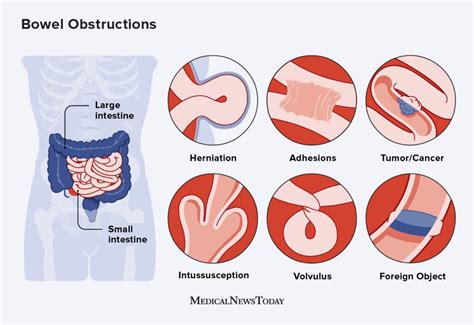Intro
Identify bowel obstruction symptoms, including abdominal pain, constipation, and vomiting, to seek timely medical help for intestinal blockage treatment and prevent complications like bowel ischemia and necrosis.
Bowel obstruction is a serious medical condition that occurs when the small or large intestine is partially or completely blocked, preventing the normal flow of food, fluids, and gas. This condition can be life-threatening if left untreated, and it's essential to recognize the symptoms early on to seek medical attention promptly. Bowel obstruction can be caused by various factors, including hernias, adhesions, tumors, and twisting of the intestine. Understanding the symptoms and seeking medical help quickly can make a significant difference in treatment outcomes.
The symptoms of bowel obstruction can vary depending on the location and severity of the blockage. In some cases, the symptoms may develop gradually over time, while in other cases, they may appear suddenly. It's crucial to be aware of the potential symptoms to ensure timely medical intervention. Some common symptoms of bowel obstruction include severe abdominal pain, vomiting, bloating, and constipation. In severe cases, bowel obstruction can lead to life-threatening complications, such as tissue death, perforation, and peritonitis.
Recognizing the symptoms of bowel obstruction is critical to prevent long-term damage and ensure effective treatment. If left untreated, bowel obstruction can lead to severe complications, including intestinal ischemia, sepsis, and even death. Therefore, it's essential to seek medical attention immediately if you or someone you know is experiencing symptoms of bowel obstruction. A healthcare professional can diagnose the condition using various diagnostic tests, including imaging studies, blood tests, and physical examinations. With prompt medical attention, it's possible to treat bowel obstruction effectively and prevent long-term damage.
Causes and Risk Factors

Bowel obstruction can be caused by various factors, including internal and external factors. Internal factors include adhesions, hernias, tumors, and twisting of the intestine, while external factors include compression from outside the intestine, such as from a hernia or tumor. Adhesions are bands of fibrous tissue that can form between loops of intestine or between the intestine and other organs, causing the intestine to become stuck together. Hernias occur when a portion of the intestine bulges through a weakened area in the abdominal wall, which can cause compression and obstruction. Tumors, either benign or malignant, can grow in the intestine and cause a blockage. Twisting of the intestine, also known as volvulus, can cut off blood flow to the intestine, leading to tissue death.
Types of Bowel Obstruction
Bowel obstruction can be classified into two main types: partial and complete. Partial bowel obstruction occurs when the intestine is only partially blocked, allowing some food, fluids, and gas to pass through. Complete bowel obstruction, on the other hand, occurs when the intestine is completely blocked, preventing any food, fluids, or gas from passing through. Both types of bowel obstruction require medical attention, and treatment outcomes depend on the severity and location of the blockage.Symptoms and Diagnosis

The symptoms of bowel obstruction can vary depending on the location and severity of the blockage. Common symptoms include severe abdominal pain, vomiting, bloating, and constipation. In some cases, patients may experience abdominal tenderness, guarding, and rebound tenderness. Abdominal pain is often severe and may be crampy or colicky, and it may worsen over time. Vomiting can occur, especially if the obstruction is high in the intestinal tract. Bloating and constipation are also common symptoms, as the intestine becomes distended with gas and fluid.
Diagnostic Tests
Diagnosing bowel obstruction requires a combination of physical examination, medical history, and diagnostic tests. Imaging studies, such as X-rays, CT scans, and MRI scans, can help identify the location and severity of the blockage. Blood tests can help rule out other conditions and assess for signs of infection or tissue death. A physical examination can help identify abdominal tenderness, guarding, and rebound tenderness. In some cases, a healthcare professional may perform a rectal examination to check for blood or mucus in the stool.Treatment and Management

Treatment for bowel obstruction depends on the severity and location of the blockage. In some cases, bowel obstruction can be treated with conservative management, such as bowel rest, fluid replacement, and pain management. In other cases, surgical intervention may be necessary to relieve the obstruction and restore normal intestinal function. Bowel rest involves stopping oral intake and allowing the intestine to rest, while fluid replacement involves administering intravenous fluids to prevent dehydration. Pain management involves administering pain medication to control abdominal pain.
Surgical Intervention
Surgical intervention may be necessary to relieve the obstruction and restore normal intestinal function. The type of surgery depends on the location and severity of the blockage, as well as the underlying cause. In some cases, a healthcare professional may perform a laparoscopic surgery, which involves making small incisions in the abdominal wall to insert a laparoscope and surgical instruments. In other cases, an open surgery may be necessary, which involves making a larger incision in the abdominal wall to access the intestine.Complications and Prevention

Bowel obstruction can lead to severe complications if left untreated, including tissue death, perforation, and peritonitis. Tissue death occurs when the intestine becomes ischemic, leading to cell death and tissue necrosis. Perforation occurs when the intestine ruptures, leading to leakage of intestinal contents into the abdominal cavity. Peritonitis occurs when the abdominal cavity becomes inflamed, leading to severe abdominal pain, fever, and sepsis.
Prevention Strategies
Preventing bowel obstruction requires a combination of lifestyle modifications and medical interventions. Eating a high-fiber diet can help prevent constipation and reduce the risk of bowel obstruction. Staying hydrated can help prevent dehydration and reduce the risk of bowel obstruction. Avoiding heavy lifting and bending can help prevent hernias, which can cause bowel obstruction. Managing underlying medical conditions, such as diabetes and hypertension, can help reduce the risk of bowel obstruction.Living with Bowel Obstruction

Living with bowel obstruction requires a combination of medical management and lifestyle modifications. Patients with bowel obstruction may need to follow a special diet, avoiding foods that can exacerbate symptoms. They may also need to take medications to manage symptoms, such as pain medication and anti-nausea medication. In some cases, patients may need to undergo surgical intervention to relieve the obstruction and restore normal intestinal function.
Coping Strategies
Coping with bowel obstruction requires a combination of emotional support and practical strategies. Patients with bowel obstruction may experience anxiety, depression, and stress, which can exacerbate symptoms. Seeking emotional support from family, friends, and healthcare professionals can help patients cope with the condition. Practicing stress-reducing techniques, such as meditation and deep breathing, can help manage symptoms and improve quality of life.What are the symptoms of bowel obstruction?
+The symptoms of bowel obstruction include severe abdominal pain, vomiting, bloating, and constipation. In some cases, patients may experience abdominal tenderness, guarding, and rebound tenderness.
How is bowel obstruction diagnosed?
+Bowel obstruction is diagnosed using a combination of physical examination, medical history, and diagnostic tests, including imaging studies, blood tests, and physical examinations.
What are the treatment options for bowel obstruction?
+Treatment for bowel obstruction depends on the severity and location of the blockage. In some cases, bowel obstruction can be treated with conservative management, such as bowel rest, fluid replacement, and pain management. In other cases, surgical intervention may be necessary to relieve the obstruction and restore normal intestinal function.
In conclusion, bowel obstruction is a serious medical condition that requires prompt medical attention. Recognizing the symptoms and seeking medical help quickly can make a significant difference in treatment outcomes. By understanding the causes, symptoms, and treatment options for bowel obstruction, patients can take an active role in managing their condition and improving their quality of life. If you or someone you know is experiencing symptoms of bowel obstruction, don't hesitate to seek medical attention. With prompt treatment and management, it's possible to overcome bowel obstruction and regain normal intestinal function. We encourage you to share your experiences and ask questions in the comments section below, and don't forget to share this article with others who may be affected by bowel obstruction.
